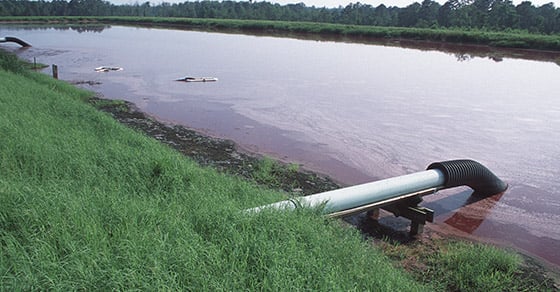Not unlike the hurricanes before it, Hurricane Matthew has again brought the issues surrounding manure lagoons to light in the wake of the country’s most recent natural disaster.
Lagoons are large, open-air storage pits for manure, now the norm at most intensive animal farming operations (CAFOs), and long the center of controversy.
Lagoons have been a highly debated topic in the area hit by Hurricane Matthew for many years, where hurricanes in 1996 (Hurricane Fran), 1998 (Hurricane Bonnie), and most notably 1999 (Hurricane Floyd) ravaged lagoons leaving devastating impacts on the surrounding area.
And while Hurricane Floyd prompted North Carolina officials to take action to reduce the amount of facilities in the floodplain, many still exist, and hurricanes are not the only issue plaguing them.
As damage from the hurricane to the nation’s second largest pork producing state becomes more clear, manure lagoons are again at the center of controversy for the risk they pose to the surrounding water table and ecology, with many calling for a sustainable solution to the ever-problematic pits.
As frustrations over lagoons escalate, some options for curbing the use of lagoons are likely on the horizon, with options including manure nutrient recovery and bedding recovery from manure. These options not only reduce the need for lagoons, but they also take advantage of the valuable nutrients and organic matter contained within manure.
Why Manure Lagoons are a Problem
Lagoons can be Flooded
History has shown that lagoons situated in floodplains are a severe risk for contaminating surface and groundwater in the wake of flooding, as is evidenced by the many hurricanes that have left contamination in their path as a result.
While Ag Annex reported on October 14th, that according to the North Carolina Pork Council, no lagoon breaches had yet been reported as a result of Hurricane Matthew, 11 lagoons have been reported as inundated (flooded), spreading hog manure and all of its associated risks over the nearby landscape and into rivers.
Lagoons are Susceptible to Damage Over Time
While hurricanes are often the worst case scenario, it’s not just hurricanes that bring the issues to light; lagoons are the subject of a laundry list of documented incidents and causes for concern not related to flooding.
Lagoons are susceptible to breaches, erosion, leaking, and even overflow, releasing manure, excess nutrients, and bacteria into everything touched by the contents.
In 2010, an old drainage structure led to the erosion that caused a catastrophic breach in a Washington state lagoon, sending millions of gallons of liquid manure onto surrounding land, into French Slough, and the Snohomish River.
The effects of such contamination are devastating, killing off fish and causing algal blooms, and allowing harmful contaminants to reach the drinking water of many, resulting in sickness and other related issues.
Lagoons Cause Air Pollution
The unregulated release of liquid manure into surrounding areas is not the only worry around lagoons; air quality is also a major concern, and not just for the offensive odors lagoons often emit.
The natural breakdown of manure that occurs in lagoons releases harmful gases into the air, namely Hydrogen Sulfide, Methane, Ammonia, and Carbon Dioxide. The associated health risks of such gases are grim, resulting in toxic reaction in both humans and animals.
As large, open pits filled with a slurry-like material releasing often concentrated toxic gases, lagoons are also a hazard for workers.
Many lives have been claimed as a result of workers being overcome by the toxic gases produced by lagoons, often subsequently falling into pits or being unable to exit. It is not uncommon for these scenarios to result in multiple fatalities, as others follow suit in futile rescue attempts.
Options to Reduce the Use of Manure Lagoons
While regulation around CAFO waste management is on the rise, new technologies are still needed to provide improved means of not only managing animal waste, but fully utilizing the valuable organic matter and nutrient content contained within.
FEECO has been working with companies around two promising methods that would reduce the need for lagoons: the use of manure as livestock bedding, and the recovery of nutrients from manure for use as a fertilizer or soil amendment product.
Manure Bedding Recovery
Manure can be processed via solid/liquid separation with an optional anaerobic digestion step to reduce moisture and pathogen content, producing a bedding referred to as Recycled Manure Solids (RMS).
The Recycled Manure Solids can then be dried to further reduce moisture and pathogen content, producing a Dried Manure Solids (DMS) bedding product, ideal for use as livestock bedding.
While this approach may not be applicable to many swine farms, it is a viable option when a bedding product is utilized (although many farms do not utilize a bedding product, a recent article stemming from a course at the University of Massachusetts – Amherst recommends that all swine have access to straw bedding in order to encourage more natural behavior, as well as provide a comfortable padding for the animals and reduce joint problems).
Manure Nutrient Recovery
After pre-treatment, manure can be processed through a granulation system to produce a fertilizer or soil amendment product. This process produces a highly customizable, premium product through a series of steps designed to reduce moisture and pathogen content, and create a fertilizer granule ideal for easy storage, transport, handling, and application.
Opportunity also exists to use these technologies in tandem to create a sustainable, on-farm waste management solution that allows farmers to be self-sufficient in providing their nutrient and bedding needs.
This approach in particular, would reduce the majority of nutrients going into lagoons. Additionally, with regular irrigation of nutrient depleted tea water throughout the growing season, the overall size and amount of irrigation water in the lagoons at any given time would be significantly reduced, ultimately decreasing the associated risks.
Conclusion
As CAFOs become the new norm of the agriculture industry, the issues surrounding the use of lagoons will continue to be in the spotlight, demanding technologies for alternate solutions. The use of manure as a bedding and/or granular fertilizer offers viable methods for reducing both the need for and size of lagoons.
FEECO has been working with companies since 1951 to transform waste materials, including manure, into value-added products. We offer complete granulation systems, custom equipment, material testing, and process and product development services, as well as dryers for producing Dried Manure Solids (DMS) bedding. For more information on our manure reuse technologies, contact us today.



